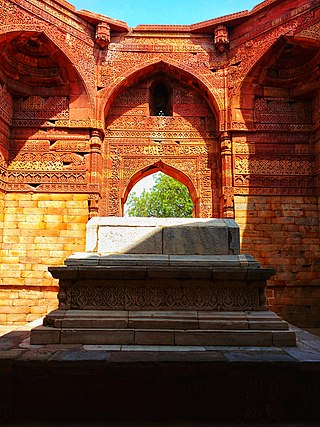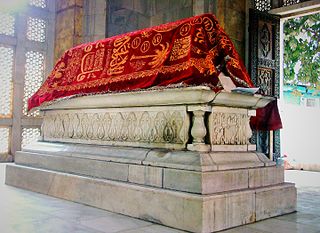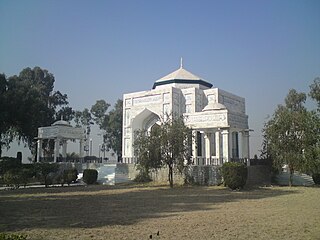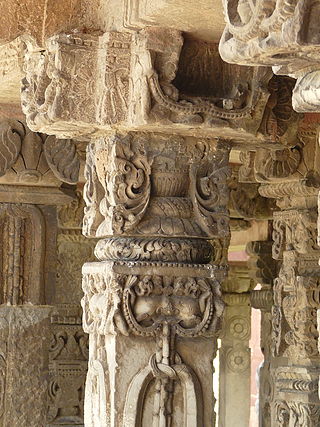Related Research Articles

The Delhi Sultanate, or the Sultanate of Delhi, was a Muslim empire based in Delhi that stretched over large parts of the Indian subcontinent during the period of Medieval India, for 320 years (1206–1526). Following the invasion of South Asia by the Ghurid dynasty, five unrelated heterogeneous dynasties ruled over the Delhi Sultanate sequentially: the Mamluk dynasty (1206–1290), the Khalji dynasty (1290–1320), the Tughlaq dynasty (1320–1414), the Sayyid dynasty (1414–1451), and the Lodi dynasty (1451–1526). It covered large swaths of territory in modern-day India, Pakistan, and Bangladesh as well as some parts of southern Nepal.

Mu'izz ad-Din Muhammad ibn Sam, , popularly known as Muhammad of Ghor, or simply Muhammad Ghori, was a ruler from the Ghurid dynasty based in Ghor in present-day central Afghanistan who ruled from 1173 to 1206. Muhammad of Ghor and his sibling Ghiyath al-Din Muhammad ruled in dyarchy untill the death of the latter in 1203 with Ghiyath al-Din Muhammad, the senior partner in the dyarchy governing the western region of Ghurid Empire from his capital at Firozkoh while his junior partner Muhammad of Ghor extended the Ghurid dominions eastwards and laid the foundation of Islamic rule in the Indian Subcontinent, which lasted after him for nearly half a millennium under the evolving Muslim dynasties.

Shams ud-Din Iltutmish was the third of the Mamluk kings who ruled the former Ghurid territories in northern India. He was the first Muslim sovereign to rule from Delhi, and is thus considered the effective founder of the Delhi Sultanate.

Qutb ud-Din Aibak, was a Turkic general of the Ghurid king Muhammad Ghori. He was in charge of the Ghurid territories in northern India, and after Muhammad Ghori's assassination in 1206, he established the Delhi Sultanate (1206–1526), and started the Mamluk dynasty, which would rule the Sultanate until 1290.

The Mamluk dynasty was founded in Northern India by Qutb ud-Din Aibak, a Turkic Mamluk slave-general of the Ghurid Empire from Central Asia. The Mamluk dynasty ruled from 1206 to 1290; it was the first of five unrelated dynasties to rule as the Delhi Sultanate until 1526. Before the establishment of the Mamluk dynasty, Qutb al-Din Aibak's tenure as a Ghurid dynasty administrator lasted from 1192 to 1206, a period during which he led forays into the Gangetic plain and established control over some of the new areas.

Prithviraja III, popularly known as Prithviraj Chauhan or Rai Pithora, was a king from the Chauhan (Chahamana) dynasty who ruled the territory of Sapadalaksha, with his capital at Ajmer in present-day Rajasthan. Ascending the throne as a minor in 1177 CE, Prithviraj inherited a kingdom which stretched from Thanesar in the north to Jahazpur (Mewar) in the south, which he aimed to expand by military actions against neighbouring kingdoms, most notably defeating the Chandelas.
The Ghurid dynasty was a Persianate dynasty of presumably eastern Iranian Tajik origin, which ruled from the 10th-century to 1215. The Ghurids were centered in the hills of Ghor region in the present-day central Afghanistan, where they initially started out as local chiefs. They gradually converted to Sunni Islam from Buddhism after the conquest of Ghor by the Ghaznavid ruler Mahmud of Ghazni in 1011. The Ghurids eventually overrun the Ghaznavids when Muhammad of Ghor seized Lahore and expelled the Ghaznavids from their last stronghold.

The Second Battle of Tarain was fought in 1192 between the Ghurid forces of Muhammad Ghuri and the Rajput Confederacy of Prithviraj Chauhan. It took place near Tarain, which is 110 kilometres (68 mi), north of Delhi. The battle ended in a decisive victory for the invading Ghurids and their successful penetration in north Indian plain.

Lal Kot or Qila Rai Pithora is a fortified complex in present-day Delhi, which includes the Qutb Minar complex. It was constructed in the reign of Tomar king Anangpal Tomar between c. 1052 - c.1060 CE. It is termed as the "First city of Delhi". Remains of the fort walls are scattered across South Delhi, visible in present Saket, Mehrauli around Qutb complex, Sanjay Van, Kishangarh and Vasant Kunj areas.
Aram Shah was the second Sultan of the Delhi Sultanate. He briefly held the throne from Lahore after the unexpected death of Qutb ud-Din Aibak before being defeated and dethroned by Iltutmish who began ruling from Delhi.

Rukn-ud-din Firuz, also transliterated as Rukn al-Din Firoz, was a ruler of Delhi sultanate for less than seven months in 1236. As a prince, he had administered the Badaun and Lahore provinces of the Sultanate. He ascended the throne after the death of his father Iltutmish, a powerful Mamluk ruler who had established the Sultanate as the most powerful kingdom in northern India. However, Ruknuddin spent his time in pursuing pleasure, and left his mother Shah Turkan in control of the administration. The misadministration led to rebellions against Ruknuddin and his mother, both of whom were arrested and imprisoned. The nobles and the army subsequently appointed his half-sister Razia on the throne.

Taj al-Din Yildiz was a Turkic ghulam of the Ghurid dynasty, who, after the death of Sultan Muhammad of Ghor, became the de facto ruler of Ghazni, while, however, still recognizing Ghurid authority.

Ikhtiyār al-Dīn Muḥammad Bakhtiyār Khaljī, also known as Bakhtiyar Khalji, was a Turko-Afghan military general of the Ghurid ruler Muhammad of Ghor, who led the Muslim conquests of the eastern Indian regions of Bengal and Bihar and established himself as their ruler. He was the founder of the Khalji dynasty of Bengal, which ruled Bengal for a short period, from 1203 to 1227 CE.
The First Battle of Tarain, also spelt as the First Battle of Taroari, was fought in 1191 between the invading Ghurid army led by Muhammad of Ghor and the Rajput confederacy led by Prithviraj Chauhan, near Tarain. The battle ended in decisive victory for the Rajputs; however, Muhammad of Ghor managed to escape and returned to Ghazni.
Qutb ad-Din or Qutb-ud-Din is an Arabic male given name translated as 'the pivot of the faith' or 'axis of the faith'.
Tabaqat-i Nasiri, named for Sultan Nasir-ud-Din, is an elaborate history of the Islamic world written in Persian by Minhaj-i-Siraj Juzjani and completed in 1260. Consisting of 23 volumes and written in a blunt straightforward style, Juzjani devoted many years to the creation of this book even providing references for his information. Although a large portion of the book is devoted to the Ghurids, it also contains a history of the predecessors in Ghazna before the Ghaznavid Sebuktigin took power. In compiling his Tabaqat i Nasiri, Juzjani used other books now lost; part of Baihaqi's reign of Sebuktigin, Abu'l-Qasim Imadi's Ta'rikh-i mujadwal and most likely Ibn Haisam's Qisas-i thani. Juzjani's "tabaqat" would initiate the form of writing for dynastic history in centuries to come.
The Battle of Andkhud, also spelt as Battle of Andkhui was fought in 1204 on the bank of river Oxus near Andkhoy in present-day Afghanistan. It was fought between the Ghurid forces of Muhammad of Ghor against the Qara Khitai forces led by Tayangu of Taraz. The battle ended in a complete rout of the Ghurids, although Muhammad of Ghor managed to escape the debacle after the intervention by Uthman of Qarakhanid.

The Indian campaigns of Muhammad of Ghor were a series of invasions by the Ghurid ruler Muhammad of Ghor in the last quarter of the twelfth and early decade of the thirteenth century which lead to the widespread expansion of the Ghurid empire in the Indian subcontinent.
The siege of Lahore in 1186 brought the end of Ghaznavid rule with Muhammad of Ghor annexing their last-surviving principality from Khusrau Malik.

Malik Bahauddin Tughril, commonly known as Bahauddin Tughril or Baha al-Din Tughril was a senior Turkic slave of the Ghurid ruler Muhammad of Ghor who was in charge of the Bayana region in the present-day Indian state of Rajasthan. He was admitted into the slave-household of the Ghurids during early reign of Muhammad of Ghor and gradually emerged as one of his eminent slave lieutenant along with Qutb al-Din Aibak, playing a significant role in the Ghurid conquest of northern Indian plain.
References
- 1 2 Iqtidar Husain Siddiqi 2010, p. 40.
- 1 2 3 4 Iqtidar Husain Siddiqi 2010, p. 41.
- ↑ Khaliq Ahmad Nizami 1983, p. 55.
- ↑ Iqtidar Husain Siddiqi 2010, p. 42.
- ↑ Iqtidar Husain Siddiqi 2010, pp. 41–42.
- ↑ Iqtidar Husain Siddiqi 2010, p. 43.
- ↑ Iqtidar Husain Siddiqi 2010, p. 46.
- ↑ Iqtidar Husain Siddiqi 2010, p. 52.
- ↑ Peter Jackson 2003, p. 7.
Bibliography
- Iqtidar Husain Siddiqi (2010). Indo-Persian Historiography Up to the Thirteenth Century. Primus Books. ISBN 978-81-908918-0-6.
- Khaliq Ahmad Nizami (1983). On history and historians of medieval India. Munshiram Manoharlal. ISBN 9788121501521. OCLC 832916392.
- Peter Jackson (2003). The Delhi Sultanate: A Political and Military History. Cambridge University Press. ISBN 978-0-521-54329-3.